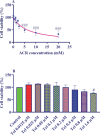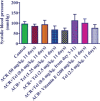Investigating the effect of telmisartan on acrylamide-induced neurotoxicity through in vitro and in vivo methods
- PMID: 37605730
- PMCID: PMC10440133
- DOI: 10.22038/IJBMS.2023.69636.15167
Investigating the effect of telmisartan on acrylamide-induced neurotoxicity through in vitro and in vivo methods
Abstract
Objectives: Acrylamide (ACR) is an environmental contaminant and neurotoxin. Telmisartan is an AT1 blocker that has neuroprotective properties basically through its anti-oxidant effect. The effect of telmisartan on ACR-induced neurotoxicity was investigated in this study.
Materials and methods: Male Wistar rats were randomly assigned to eight groups (n=6): 1:Control (normal saline), 2:ACR (50 mg/kg, 11 days, IP), 3:ACR+vitamin E (200 mg/kg, every other day, 11 days), 4-6:ACR+telmisartan (0.6, 1.25, and 2.5 mg/kg, 11 days, IP), 7:ACR+telmisartan (0.6 mg/kg, days 3-11), 8:Telmisartan (2.5 mg/kg, 11 days). The behavioral test and blood pressure were assessed after 11 days. Then, the levels of MDA and GSH in brain tissue were measured. The MTT assay was used to evaluate the effect of telmisartan on ACR-induced cytotoxicity.
Results: Exposing PC12 cells to ACR decreased cell viability versus the control group. Pretreating PC12 cells with telmisartan (0.0125, 0.025 µM) enhanced cell viability compared with the ACR group. Compared with control samples, ACR significantly caused motor impairment, elevated MDA, and reduced GSH levels. Locomotor abnormalities were significantly ameliorated by telmisartan (0.6, 1.25 mg/kg, 11 days) and vitamin E versus the ACR group. Receiving telmisartan (0.6, 1.25, and 2.5 mg/kg) and vitamin E along with ACR decreased MDA levels and enhanced GSH content compared with the ACR group. There was no significant difference in animal blood pressure between the groups.
Conclusion: Oxidative stress has a chief role in the neurotoxicity of ACR. Telmisartan (in doses that do not affect blood pressure) ameliorated ACR-induced toxicity by inhibiting oxidative stress.
Keywords: Anti-oxidants; Cell survival; Motor disorders; Neurotoxins; PC12 cells; Vitamin E.
Conflict of interest statement
We declare that we have no conflicts of interest.
Figures





Similar articles
-
Attenuation of acrylamide-induced neurotoxicity by supplementation of sitagliptin in Wistar rats.Iran J Basic Med Sci. 2024;27(3):311-318. doi: 10.22038/IJBMS.2023.73187.15905. Iran J Basic Med Sci. 2024. PMID: 38333747 Free PMC article.
-
Evaluating the effect of alpha-mangostin on neural toxicity induced by acrylamide in rats.Environ Sci Pollut Res Int. 2023 Sep;30(42):95789-95800. doi: 10.1007/s11356-023-29162-9. Epub 2023 Aug 9. Environ Sci Pollut Res Int. 2023. PMID: 37556057
-
Effect of carnosic acid on acrylamide induced neurotoxicity: in vivo and in vitro experiments.Drug Chem Toxicol. 2022 Jul;45(4):1528-1535. doi: 10.1080/01480545.2020.1845715. Epub 2020 Nov 19. Drug Chem Toxicol. 2022. PMID: 33213219
-
Protective effect of aspirin and gentisic acid, a plant-derived phenolic acid, on acrylamide-induced neurotoxicity by inhibiting apoptosis and autophagy.Naunyn Schmiedebergs Arch Pharmacol. 2025 Apr;398(4):3895-3911. doi: 10.1007/s00210-024-03498-6. Epub 2024 Oct 5. Naunyn Schmiedebergs Arch Pharmacol. 2025. PMID: 39367985
-
Protective effects of selenium on acrylamide-induced neurotoxicity and hepatotoxicity in rats.Iran J Basic Med Sci. 2021 Aug;24(8):1041-1049. doi: 10.22038/ijbms.2021.55009.12331. Iran J Basic Med Sci. 2021. PMID: 34804421 Free PMC article.
Cited by
-
Ameliorative and protective effects of coenzyme Q10 against natural and chemical toxicity: a narrative review.Naunyn Schmiedebergs Arch Pharmacol. 2025 Aug;398(8):9817-9850. doi: 10.1007/s00210-025-03992-5. Epub 2025 Mar 13. Naunyn Schmiedebergs Arch Pharmacol. 2025. PMID: 40080152 Review.
-
Attenuation of acrylamide-induced neurotoxicity by supplementation of sitagliptin in Wistar rats.Iran J Basic Med Sci. 2024;27(3):311-318. doi: 10.22038/IJBMS.2023.73187.15905. Iran J Basic Med Sci. 2024. PMID: 38333747 Free PMC article.
References
-
- Ghasemzadeh Rahbardar M, Hemadeh B, Razavi BM, Eisvand F, Hosseinzadeh H. Effect of carnosic acid on acrylamide induced neurotoxicity: in vivo and in vitro experiments. Drug Chem Toxicol. 2022;45:1528–1535. - PubMed
-
- Powers SJ, Mottram DS, Curtis A, Halford NG. Acrylamide levels in potato crisps in Europe from 2002 to 2016. Food Addit Contam. 2017;34:2085–2100. - PubMed
-
- Bušová M, Bencko V, Laktičová KV, Holcátová I, Vargová M. Risk of exposure to acrylamide. Cent Eur J Public Health. 2020;28:S43–S46. - PubMed
LinkOut - more resources
Full Text Sources
Research Materials
